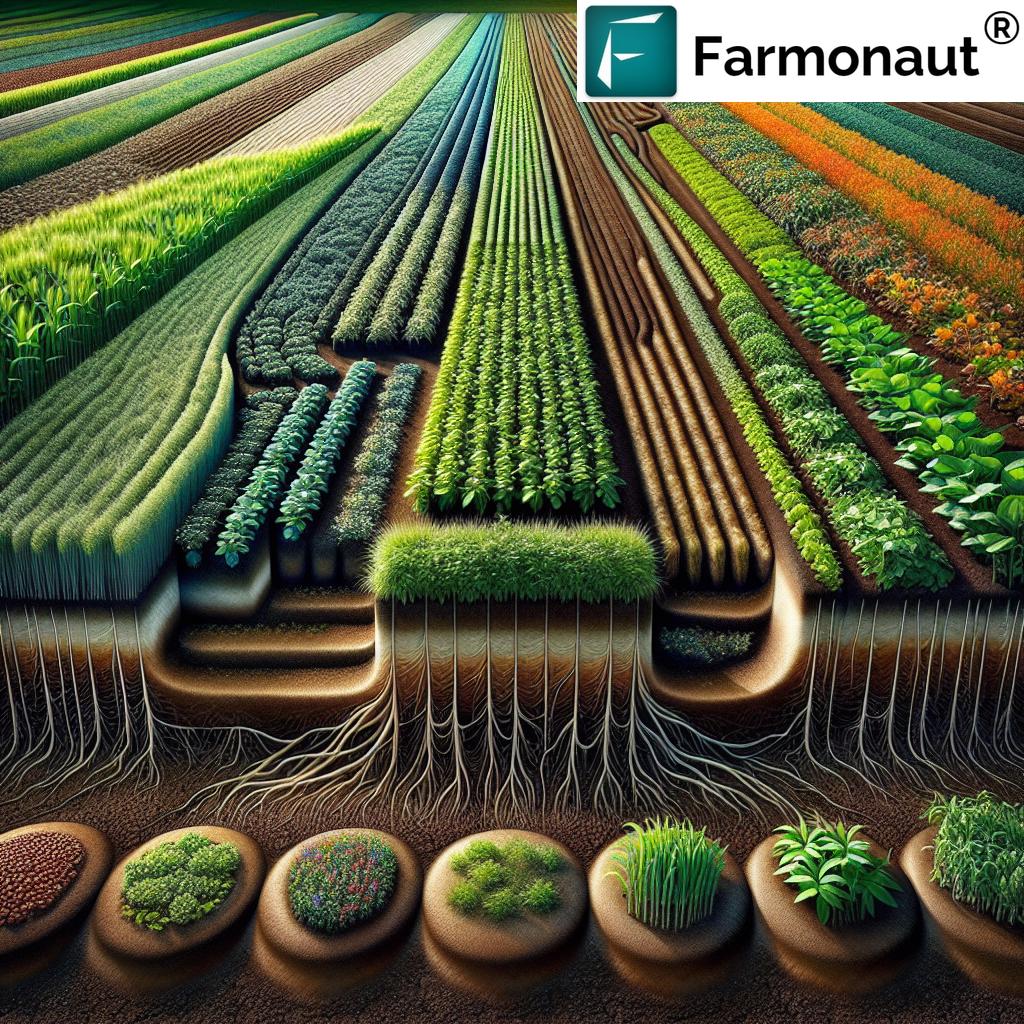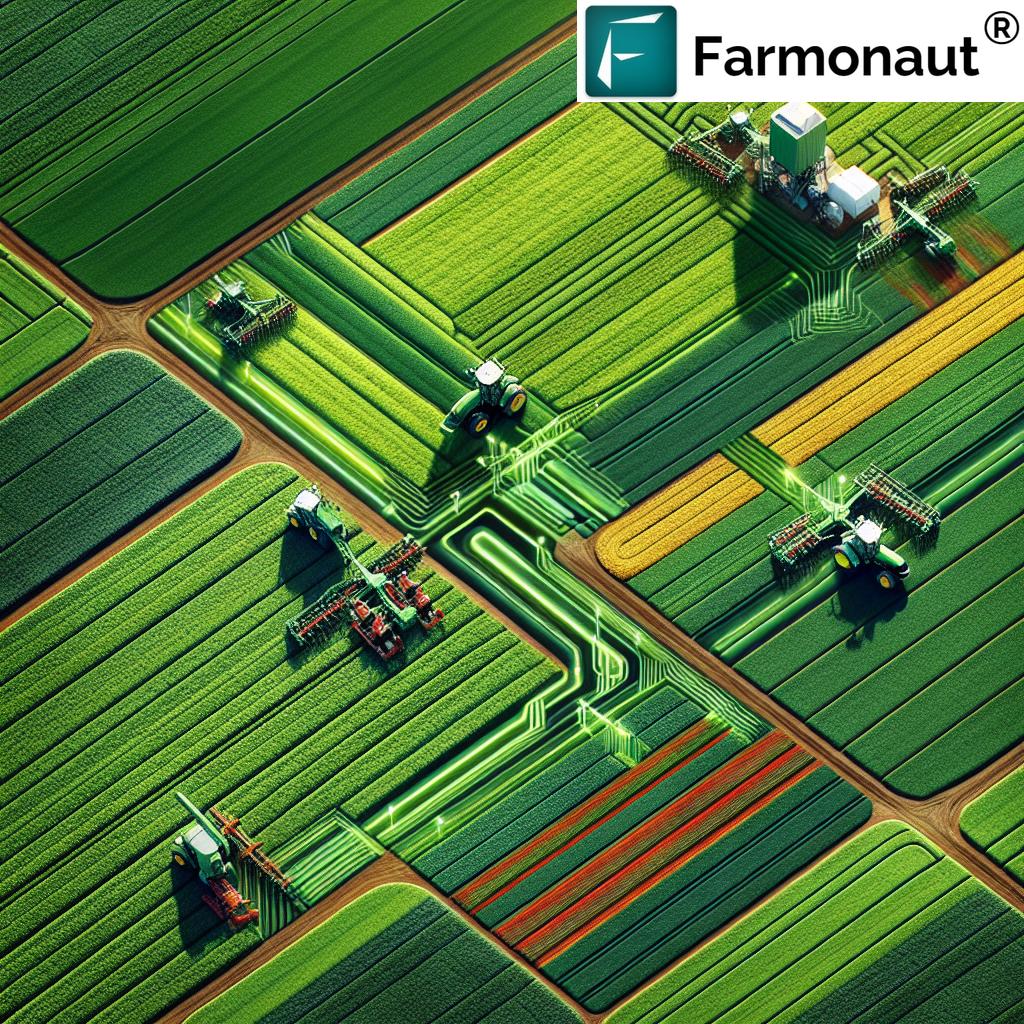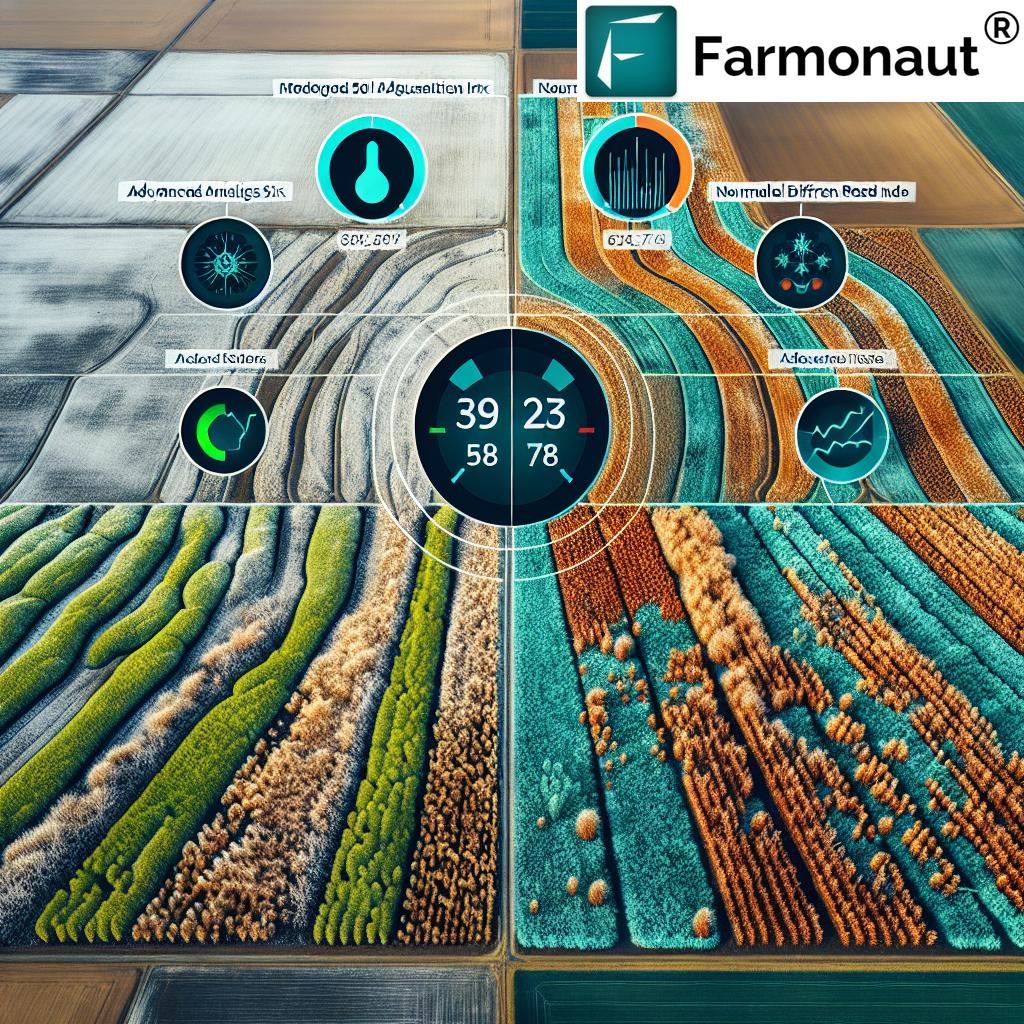Understanding Phytotoxicity: Causes, Symptoms, and Prevention in Crop Management

As agricultural experts and providers of advanced satellite-based farm management solutions at Farmonaut, we understand the critical importance of addressing phytotoxicity in crop management. In this comprehensive guide, we will delve deep into the world of phytotoxicity, exploring its causes, symptoms, and prevention strategies to help farmers and agronomists protect their valuable crops.
What is Phytotoxicity?
Phytotoxicity refers to the toxic effect of a compound on plant growth. It occurs when plants are exposed to substances that can cause damage or injury to their tissues, leading to various symptoms and potentially reducing crop yield and quality. Understanding phytotoxicity is crucial for effective crop management and ensuring optimal plant health.
Causes of Phytotoxicity
Phytotoxicity can be caused by various factors, including:
- Pesticides and Herbicides: Improper application or overuse of these chemicals can lead to plant injury.
- Environmental Conditions: Extreme temperatures, high humidity, or drought can increase the risk of phytotoxicity.
- Soil Factors: Poor soil quality, high salinity, or pH imbalances can contribute to phytotoxic effects.
- Chemical Interactions: Mixing incompatible chemicals or applying them in the wrong order can cause unexpected reactions.
- Accumulation of Toxic Substances: Buildup of harmful compounds in the soil over time can lead to chronic phytotoxicity.
Common Symptoms of Phytotoxicity
Recognizing the symptoms of phytotoxicity is crucial for early detection and intervention. Some common signs include:
- Leaf Burn: Scorched or necrotic areas on leaves, often starting at the edges.
- Chlorosis: Yellowing of leaves due to chlorophyll degradation.
- Leaf Distortion: Curling, cupping, or other abnormal leaf shapes.
- Stunted Growth: Reduced plant size or slow development.
- Flower or Fruit Abnormalities: Deformed or discolored reproductive structures.
- Root Damage: Shortened, discolored, or poorly developed root systems.
Pesticide-Induced Phytotoxicity
Pesticides are essential tools in crop protection, but they can also be a significant source of phytotoxicity if not used correctly. Here are some key points to consider:
- Label Instructions: Always carefully read and follow the product label instructions.
- Application Rate: Using more than the recommended dosage can increase the risk of phytotoxicity.
- Timing: Apply pesticides during appropriate weather conditions and growth stages.
- Plant Sensitivity: Some crops are more sensitive to certain chemicals than others.
- Tank Mixing: Be cautious when combining multiple products, as interactions can occur.
Herbicide Damage and Phytotoxicity
Herbicides are particularly prone to causing phytotoxicity, especially when applied incorrectly or to sensitive crops. Some common issues include:
- Drift Damage: When herbicides drift onto non-target plants, causing unintended injury.
- Carryover Effects: Residual herbicides in the soil affecting subsequent crops.
- Misapplication: Using the wrong herbicide for a specific crop or weed problem.
- Environmental Stress: Plants under stress are more susceptible to herbicide damage.
Environmental Factors Contributing to Phytotoxicity
Environmental conditions play a significant role in the occurrence and severity of phytotoxicity. Some key factors include:
- Temperature: Extreme heat or cold can increase plant sensitivity to chemicals.
- Humidity: High humidity can prolong chemical contact with plant surfaces.
- Soil Moisture: Drought stress can make plants more vulnerable to phytotoxic effects.
- Light Intensity: Strong sunlight can intensify the impact of certain chemicals.
- Wind: Can cause uneven distribution of sprayed chemicals or increase drift risk.
Specific Crop Sensitivities
Different crops exhibit varying levels of sensitivity to phytotoxic agents. Here are some examples:
- Basil: Highly sensitive to many fungicides and insecticides.
- Tomatoes: Can be damaged by certain herbicides, even at low concentrations.
- Grapes: Sensitive to sulfur-based fungicides, especially in hot weather.
- Soybeans: Prone to injury from carryover of some corn herbicides.
- Cucurbits: Often sensitive to oils and some insecticides.
Preventing Phytotoxicity in Crop Management
At Farmonaut, we believe prevention is key to avoiding phytotoxicity-related crop damage. Here are some essential strategies:
- Follow Label Instructions: Always adhere to the product label for application rates, timing, and safety precautions.
- Conduct Test Applications: Before large-scale use, test new products on a small area to check for adverse reactions.
- Monitor Environmental Conditions: Be aware of weather forecasts and adjust application schedules accordingly.
- Use Proper Application Techniques: Ensure even coverage and avoid over-application.
- Maintain Equipment: Regularly calibrate and clean spraying equipment to prevent contamination.
- Rotate Chemical Classes: This helps prevent the buildup of residues and reduces the risk of resistance.
- Implement Integrated Pest Management (IPM): Reduce reliance on chemicals by incorporating alternative pest control methods.
- Keep Accurate Records: Document all applications and crop responses for future reference.
The Role of Technology in Detecting and Preventing Phytotoxicity
At Farmonaut, we leverage advanced satellite technology and artificial intelligence to help farmers detect and prevent phytotoxicity issues early. Our satellite-based crop health monitoring system can identify potential problems across large areas quickly and efficiently.
| Feature | Traditional Phytotoxicity Detection | Farmonaut Satellite System Detection |
|---|---|---|
| Speed | Slow, requires physical field inspections | Rapid, covers large areas in minutes |
| Accuracy | Variable, dependent on inspector’s expertise | High, using advanced multispectral imaging |
| Cost-effectiveness | Labor-intensive and time-consuming | Highly cost-effective for large-scale monitoring |
| Coverage Area | Limited to physically accessible areas | Can monitor entire fields and regions |
Our system allows for early detection of stress patterns that may indicate phytotoxicity, enabling timely interventions and reducing the risk of widespread crop damage. To learn more about how our technology can help protect your crops, visit Farmonaut’s Crop Monitoring Platform.
Case Studies: Phytotoxicity in Different Crops
While we don’t provide specific case studies, we can discuss general scenarios where phytotoxicity has been observed in various crops:
- Corn: Herbicide carryover from previous seasons affecting growth.
- Cotton: Sensitivity to certain defoliants leading to leaf burn.
- Potatoes: Damage from drift of hormone-type herbicides used in nearby fields.
- Fruit Trees: Oil sprays applied during hot weather causing leaf drop.
The Economic Impact of Phytotoxicity
Phytotoxicity can have significant economic consequences for farmers and the agricultural industry as a whole. Some potential impacts include:
- Reduced crop yields
- Lower product quality and marketability
- Increased production costs due to replanting or additional treatments
- Potential loss of organic certification
- Legal issues related to off-target herbicide drift
Regulatory Aspects of Phytotoxicity Management
Understanding and complying with regulations is crucial for responsible pesticide use and phytotoxicity prevention. Key points include:
- Following Good Agricultural Practices (GAP)
- Adhering to Maximum Residue Limits (MRLs) for pesticides
- Proper storage and disposal of chemical products
- Maintaining application records for compliance and traceability
Future Trends in Phytotoxicity Management
At Farmonaut, we’re always looking ahead to emerging technologies and practices that can improve crop protection. Some promising developments include:
- Precision application technologies for reduced chemical use
- Development of more selective and environmentally friendly pesticides
- Advanced genetic engineering for increased crop tolerance to herbicides
- Integration of AI and machine learning for real-time crop health monitoring
To stay updated on these advancements and how they can benefit your farming operations, consider subscribing to Farmonaut’s services:
Integrating Phytotoxicity Management with Precision Agriculture
At Farmonaut, we believe that effective phytotoxicity management goes hand in hand with precision agriculture practices. Our satellite-based solutions can help farmers:
- Create precise application maps for variable rate technology
- Monitor crop health in real-time to detect early signs of stress
- Optimize resource use to reduce the risk of over-application
- Track field history to inform future management decisions
Learn more about our precision agriculture tools by visiting our Farmonaut API documentation.
The Importance of Soil Health in Phytotoxicity Prevention
Healthy soil can play a significant role in mitigating the risks of phytotoxicity. Well-managed soils can:
- Buffer against pH changes that might increase chemical availability
- Support beneficial microorganisms that can break down potential toxins
- Improve plant resilience to environmental stresses
- Enhance nutrient availability, reducing the need for excessive fertilizer use
Our soil monitoring capabilities can help you maintain optimal soil conditions. Download our mobile app for on-the-go soil health tracking:
Phytotoxicity and Sustainable Agriculture
Sustainable farming practices can significantly reduce the risk of phytotoxicity while promoting long-term soil and ecosystem health. Some key strategies include:
- Crop rotation to break pest cycles and reduce chemical dependence
- Cover cropping to improve soil structure and suppress weeds naturally
- Integrated Pest Management (IPM) to minimize pesticide use
- Biological control methods as alternatives to chemical pesticides
Our satellite monitoring system can help track the effectiveness of these practices over time. For more information on how our technology supports sustainable agriculture, visit our developer documentation.
Education and Training for Phytotoxicity Prevention
Continuous education and training are essential for staying up-to-date with the latest best practices in phytotoxicity management. We recommend:
- Attending workshops and seminars on pesticide safety and application
- Participating in online courses on integrated pest management
- Staying informed about new product formulations and their potential risks
- Collaborating with local extension services for region-specific advice
The Global Perspective on Phytotoxicity
Phytotoxicity is a concern for farmers worldwide, but its manifestation and management can vary significantly across different regions due to:
- Diverse climatic conditions affecting chemical behavior
- Varying regulatory frameworks for pesticide use
- Different crop varieties and their specific sensitivities
- Local farming practices and cultural approaches to pest management
Our global satellite coverage allows us to provide insights on phytotoxicity trends across various agricultural regions. This broad perspective helps inform best practices and risk management strategies for farmers around the world.
Phytotoxicity in Organic Farming Systems
While organic farming systems typically use fewer synthetic chemicals, phytotoxicity can still occur. Some considerations for organic farmers include:
- Potential toxicity of natural pesticides and fungicides (e.g., copper, sulfur)
- Careful management of compost and organic amendments to avoid nutrient imbalances
- Increased reliance on cultural and biological control methods
- Importance of timing and application techniques for approved organic products
Our satellite monitoring can help organic farmers track crop health and identify potential issues early, even in the absence of synthetic inputs.
Climate Change and Its Impact on Phytotoxicity Risk
As climate patterns shift, the risk and nature of phytotoxicity may also change. Some potential impacts include:
- Increased heat stress making plants more susceptible to chemical damage
- Changes in rainfall patterns affecting pesticide efficacy and movement in soil
- Shifts in pest and disease pressures leading to altered pesticide use patterns
- Potential for new crop-pesticide interactions as growing regions evolve
At Farmonaut, we continuously update our models to account for changing climate conditions, ensuring our crop monitoring remains accurate and relevant.
The Role of Genetic Engineering in Phytotoxicity Resistance
Advancements in genetic engineering are opening new possibilities for managing phytotoxicity risks:
- Development of crop varieties with enhanced tolerance to specific herbicides
- Breeding for increased resilience to environmental stresses
- Potential for crops with built-in pest resistance, reducing the need for chemical interventions
- Ongoing research into mechanisms of chemical detoxification in plants
While we don’t directly engage in genetic engineering, our satellite monitoring can help assess the performance of these new varieties in real-world conditions.
Phytotoxicity in Urban and Controlled Environment Agriculture
As agriculture expands into new environments, phytotoxicity concerns evolve:
- Unique challenges in greenhouse and vertical farming systems
- Potential for chemical accumulation in recirculating hydroponic systems
- Importance of air quality management in indoor growing environments
- Considerations for urban gardeners using treated municipal water
Our technology can be adapted to monitor crop health in these controlled environments, providing valuable insights for urban and high-tech farmers.
The Economics of Precision Application for Phytotoxicity Prevention
Investing in precision application technologies can have significant economic benefits:
- Reduced input costs through optimized chemical use
- Minimized crop damage and yield losses from phytotoxicity
- Potential for premium pricing for crops with lower chemical residues
- Long-term soil health benefits leading to sustained productivity
Our cost-benefit analysis tools can help farmers evaluate the return on investment for precision agriculture technologies.
FAQs About Phytotoxicity
Q: What is the most common cause of phytotoxicity in crops?
A: The most common cause is often the misapplication of pesticides, including incorrect dosage, timing, or application method.
Q: Can phytotoxicity occur with organic farming practices?
A: Yes, even organic-approved substances like sulfur or copper-based products can cause phytotoxicity if not used correctly.
Q: How quickly can symptoms of phytotoxicity appear?
A: Symptoms can appear within hours of application in severe cases, but may also take several days to become visible, depending on the chemical and environmental conditions.
Q: Are there any plants that are particularly sensitive to phytotoxicity?
A: Yes, some plants like basil, tomatoes, and grapes are known to be more sensitive to certain chemicals and environmental stresses.
Q: Can phytotoxicity be reversed?
A: In some cases, minor phytotoxicity can be overcome if the plant is otherwise healthy and the stress is removed. However, severe damage is often irreversible.
Q: How can satellite imaging help in managing phytotoxicity risks?
A: Satellite imaging can detect early signs of plant stress across large areas, allowing for quick identification of potential phytotoxicity issues before they become severe.
Q: What role does soil type play in phytotoxicity?
A: Soil type can affect how chemicals interact with plants. For example, sandy soils may increase leaching and reduce effectiveness, while clay soils may bind chemicals and potentially increase their concentration.
Q: How does temperature affect the risk of phytotoxicity?
A: High temperatures can increase the risk of phytotoxicity by stressing plants and potentially enhancing the uptake or volatility of certain chemicals.
Q: Can phytotoxicity occur from natural substances in the environment?
A: Yes, some plants produce allelopathic compounds that can be toxic to other plants. Additionally, natural soil contaminants or extreme pH levels can cause phytotoxic effects.
Q: How can farmers best prevent phytotoxicity?
A: The best prevention strategies include following label instructions carefully, considering environmental conditions, using proper application techniques, and implementing integrated pest management practices.

In conclusion, understanding and managing phytotoxicity is crucial for successful and sustainable crop production. By combining careful chemical management, advanced monitoring technologies, and sustainable farming practices, we can minimize the risks associated with phytotoxicity and optimize crop health and yield. At Farmonaut, we’re committed to providing farmers with the tools and insights they need to navigate these challenges effectively. For more information on how our satellite-based solutions can help you manage phytotoxicity risks and improve overall crop management, please visit our website or contact our team of experts.










